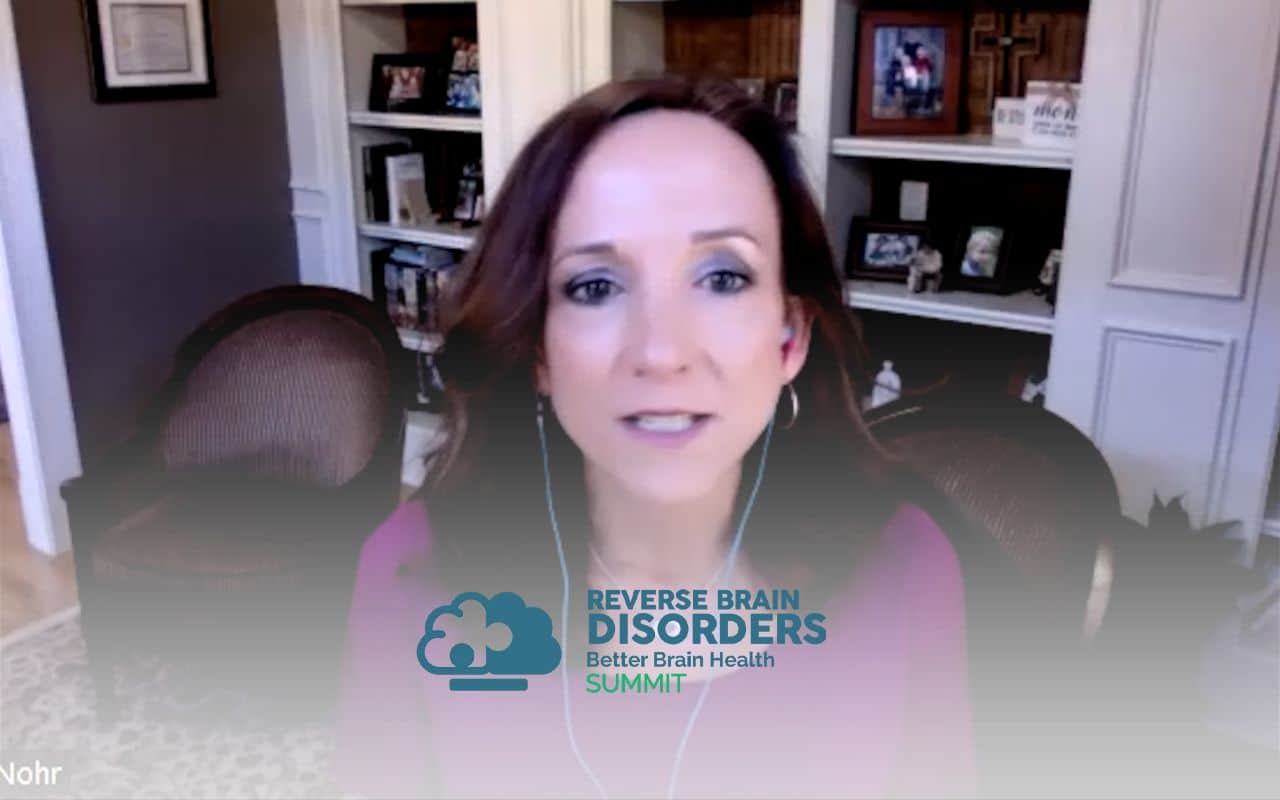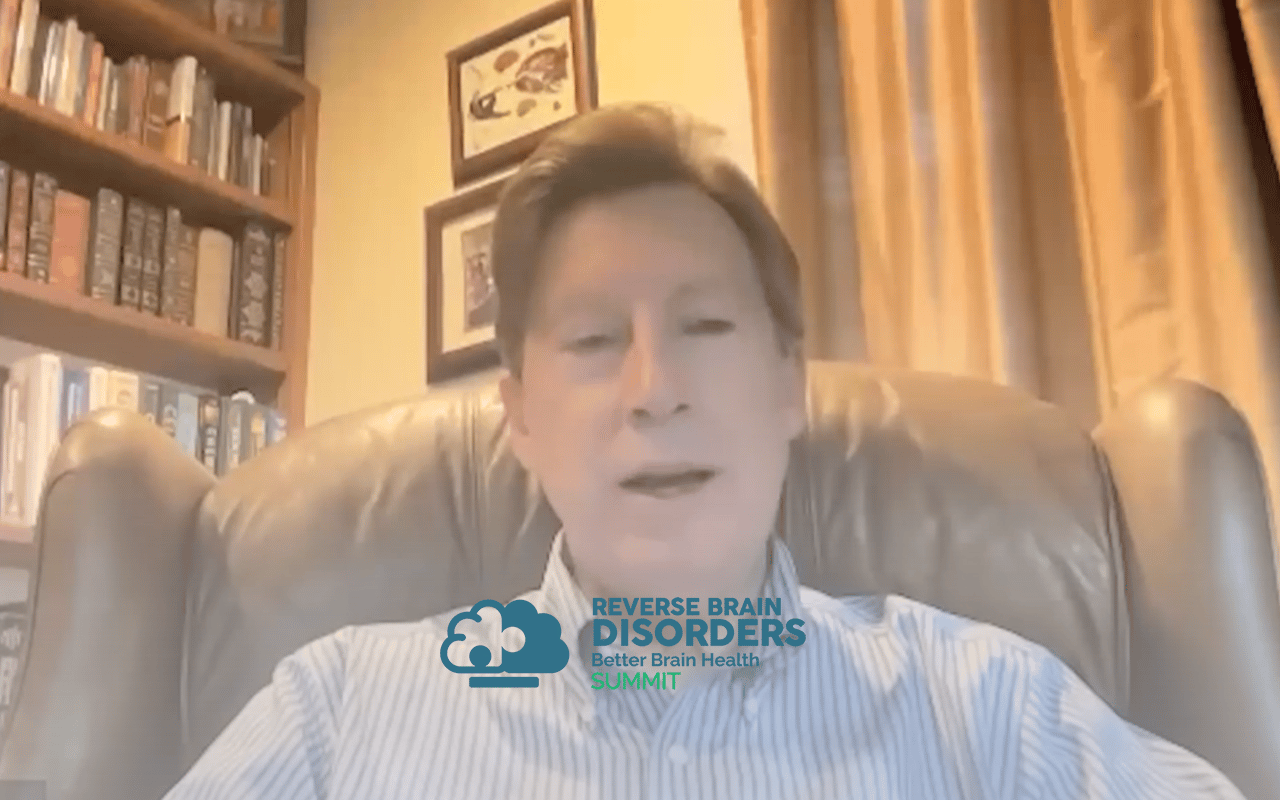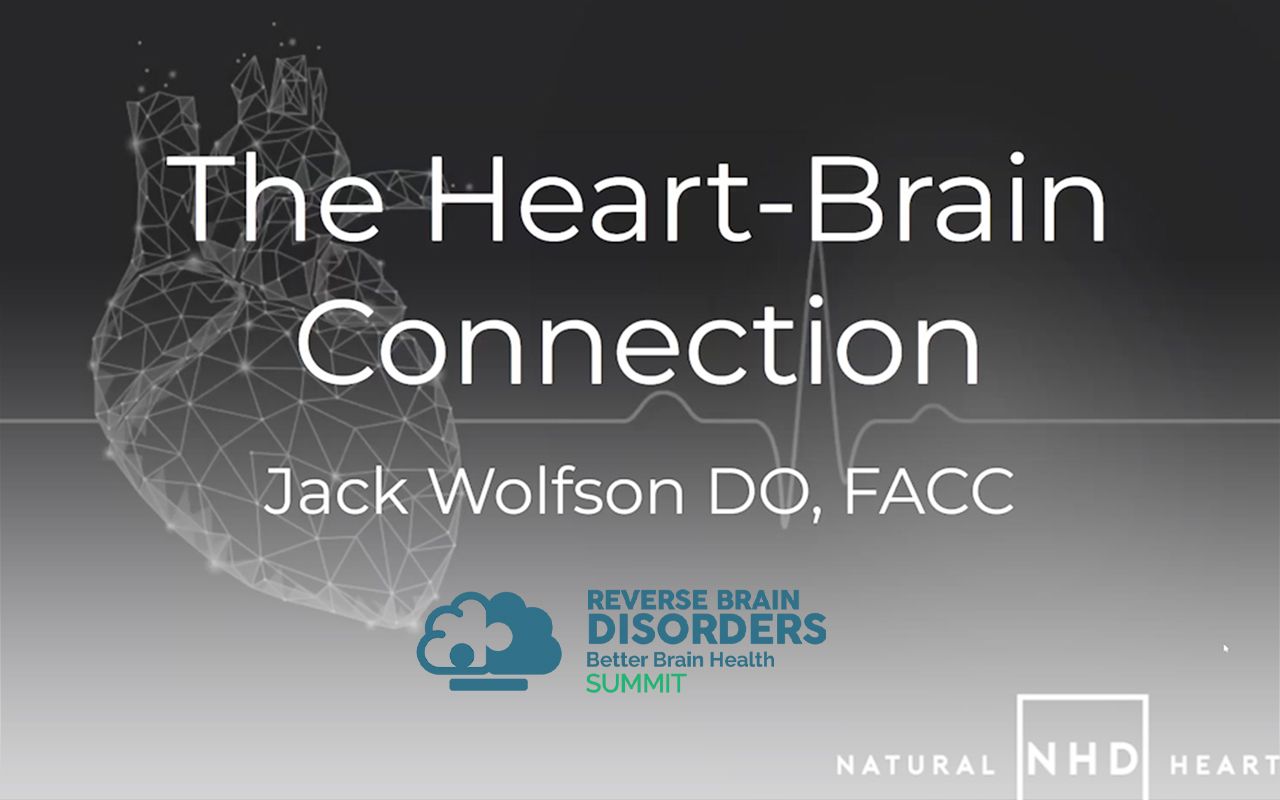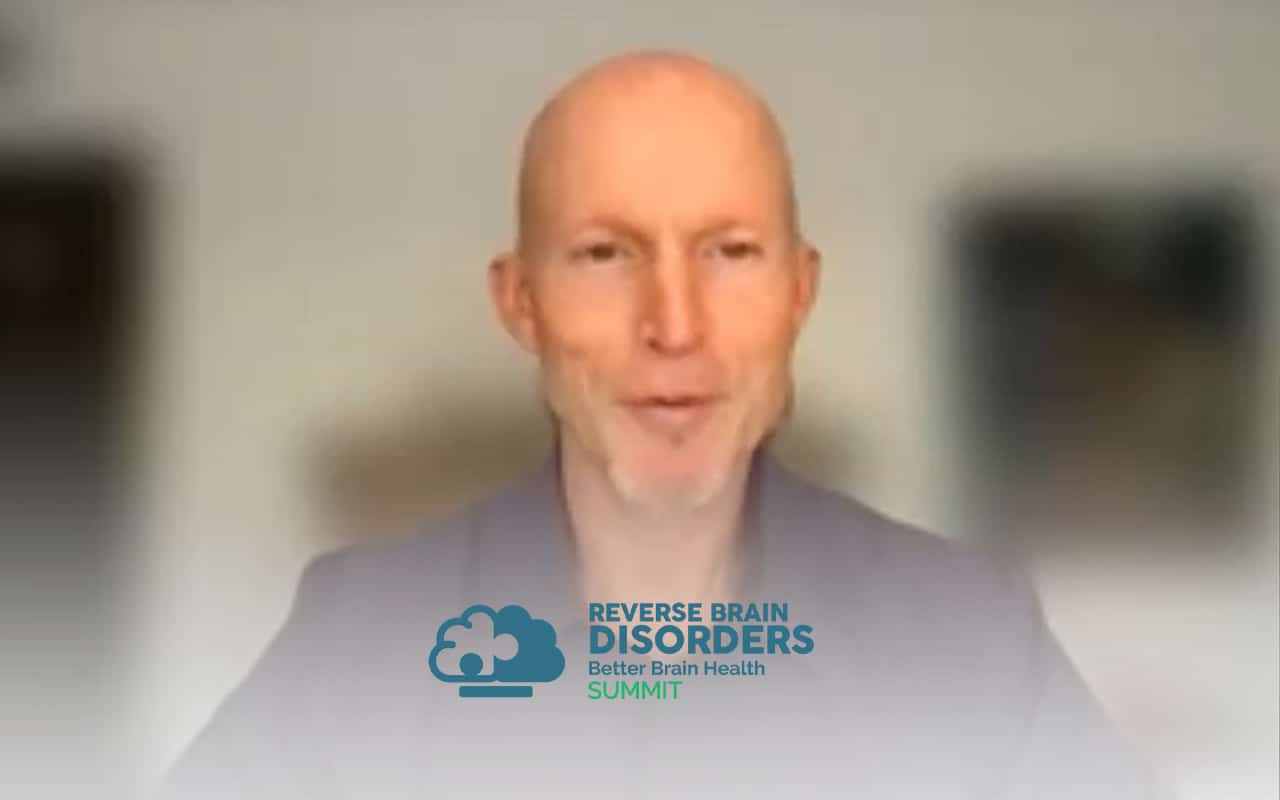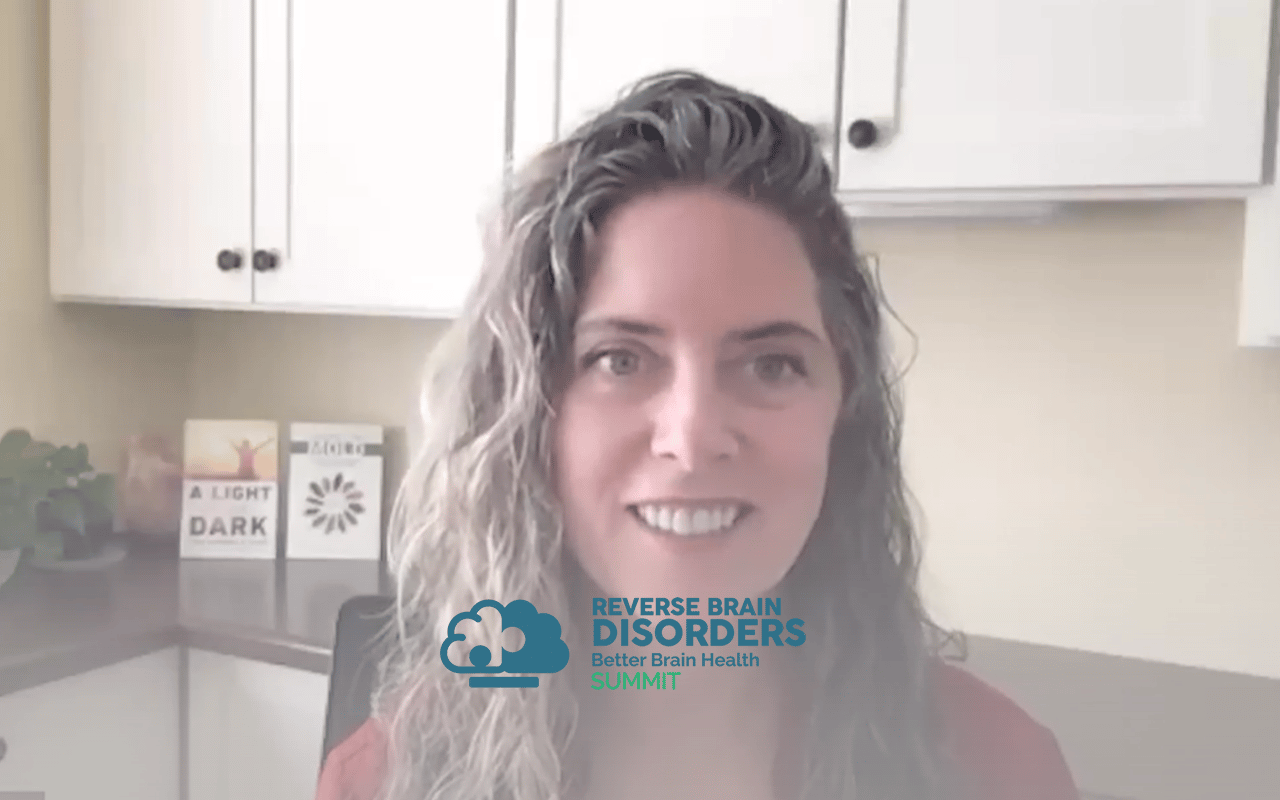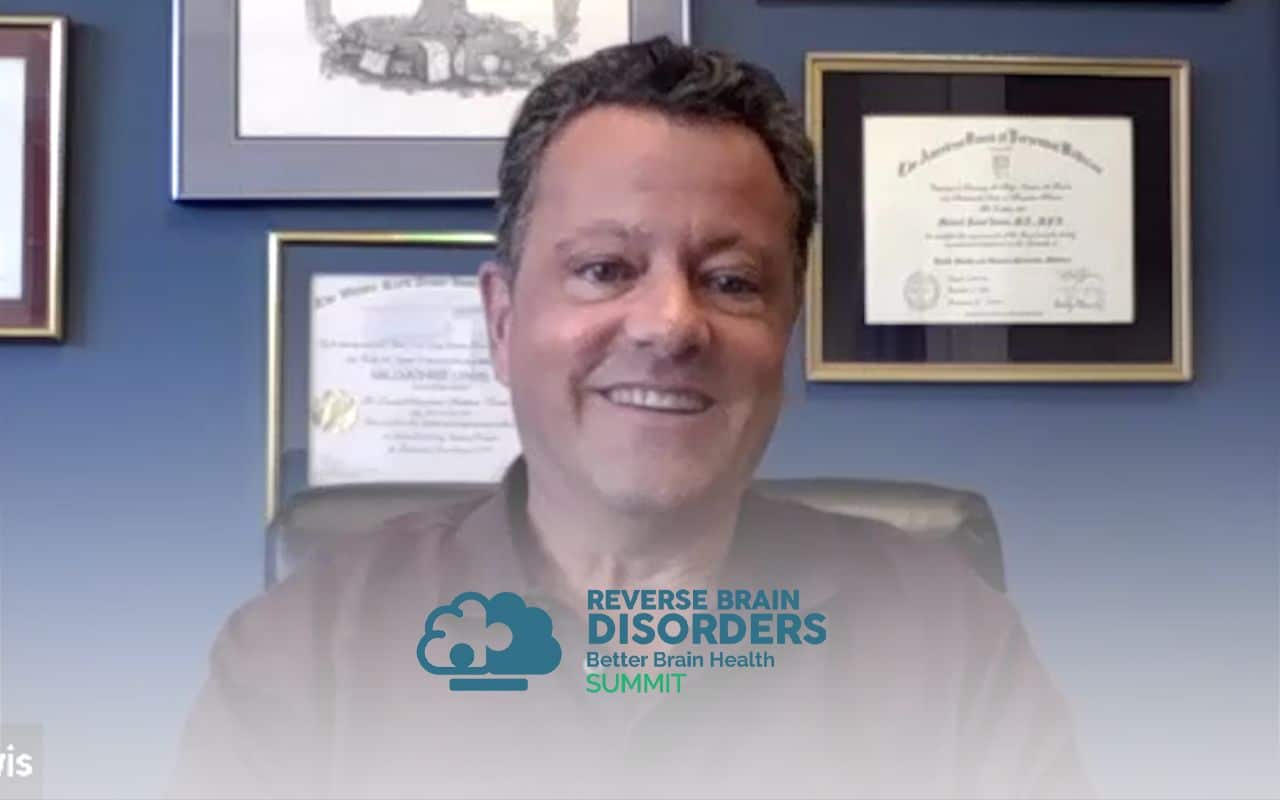Join the discussion below

Dr. Ruan is the Founder and CEO of Texas Center for Lifestyle Medicine. He devotes his career in practicing and building systems that allow for efficient delivery of healthcare. He is a board certified internal medicine physician but also have advised with companies to improve their workflow, company culture, marketing,... Read More

Melissa is a Board-Certified Health Practitioner and Certified BioIndividual Nutrition Coach. She has worked with Dr. Jockers as a health coach and writer for many years and is director of health coaching for DrJockers.com. Melissa is also a ReCode Certified Health Coach, a SIBO Mastery practitioner, and a 3x4 Genetics... Read More
- Difference Between Medical and Functional Blood Analysis
- Blood Sugar, Insulin, Glycation and Your Brain
- The Importance of Measuring Homocysteine for Brain Health
- Inflammatory and Toxin Related Biomarkers
David Jockers, DNM, DC, MS
Well. Hey there and welcome to the reverse brain disorders summit, I’m your host Dr. David Jockers and I’m excited about today’s presentation. We’re gonna talk about top blood tests and biomarkers to look at inflammation, to look at blood sugar stability, to look at different factors that may be addressing your brain health. And I have got a good friend of mine who works for my company, drjockers.com and she is an expert, her name is Melissa Nohr. She is a board certified health practitioner, a certified bio individual nutrition coach. She’s worked with me as a health coach and writer for many years. She is an avid researcher, constantly working hard to learn as much as she can and she works with clients all over the world through a virtual consulting and really has an expertise when it comes to understanding labs, translating that into creating customized protocols to help people overcome chronic health conditions. And Melissa is a recode certified health coach as well, that she did this specific training with Dr. Dale Bredesen, the author of The End of Alzheimer’s and she’s excited about that and she’s going to talk a little bit about that in this presentation. She’s also a SIBO, a small intestinal bacterial overgrowth mastery practitioner and she is a three by four genetics certified practitioner.
So she’s got a lot of great training, I have known Melissa since she was actually a patient with me, I mean gosh, we’re talking over 10 years ago, you know, 10, 12 years ago and she has just been an avid learner learning all kinds of stuff when it comes to functional health and she knows more than 99.9% of the doctors and health coaches that are out there in the world. So she is awesome. She’s an expert. You guys are gonna love this interview. So let’s go right to it. Well, Melissa, it’s always great to talk with you and I know you recently did a training with Dr. Dale Bredesen, the author of The End of Alzheimer’s and he has a great practitioner training that you went through. It’s called the Recode training. And so now you’re a recode certified health coach as well as you know, you’re also certified in genetics, three by four genetics SIBO, a number of other things. I know you’re a lifelong learner and you’re constantly looking at different programs that can help improve your skills and improve your ability to help help get people well. So what did you really get out of Dr. Bredesen’s training?
Melissa Nohr, JD, BCHHP, CBNP
Yeah, it was a phenomenal training. So I did that this past spring and I’ve been following Dr. Bredesen for years. You know, I have a special interest in neurodegeneration. I’ve worked with a number of people with cognitive decline and Parkinson’s and other issues. So I was very interested in doing just a deeper dive, which is really what his program is as a doing the health coaching program, we also had access to the practitioner program. So it was very comprehensive, I think over 100 lessons were in that program a lot on different contributors to cognitive decline? You know, Dr. Bredesen just published a clinical trial showing Alzheimer’s can be reversed. So that’s you know the first in history. So very exciting, cutting edge work that they’re doing and really just learning all the steps. There’s so many steps, there’s so many things to look at. A lot of these things we’re gonna talk about today cause there’s lab markers that we can look at to help us understand what may be contributing to cognitive decline. It was a great program. So happy to do that. There’s a lot of support. A lot of you know if you sign up for pre code or recode and choose a health coach, there’s a lot of additional downloads and you actually come up with your own pre code which is preventing cognitive decline or recode report which really guides you on what to do. So really exciting. Yeah, I’m very happy to have had that opportunity.
David Jockers, DNM, DC, MS
Yeah, that sounds really exciting. And Dr. Bredesen is doing some amazing work actually seeing people reverse Alzheimer’s is really incredible because again that’s a condition in the medical world that we’re told, all you can really do is manage it and just kind of do your best to try to slow the decline using pharmaceuticals and different things like that but not actually reverse it. And you know, the medical world never really asked the question, what is the underlying root causes or causative factors because typically it’s more than one thing that are contributing to the neurodegenerative process and that’s something that Dr. Bredesen does. And he trains practitioners like you on actually looking at root cause factors and how to actually assess those and address those for people. And lab tests play a big role with that. And so let’s get started with some of these. Well first let’s talk a little bit about some of those root cause factors. And then let’s transition there into labs that can help us look at what’s happening in the brain and and really throughout the whole body.
Melissa Nohr, JD, BCHHP, CBNP
Yes. So, well there are a lot of medical conditions that actually can affect cognitive performance. So even heart disease, diabetes, obesity, And then there’s other conditions that can mimic some of those symptoms. So B-12 deficiency or an underactive thyroid can have some of the same symptoms that people with dementia experience. So really trying to dig deep on what is the underlying factors contributing to a person’s issues and then also infections. So chronic infections, particularly gut infections, as we know the gut and brain are connected. So we always like to look at the gut, that’s one of the foundational things we do is look at gut health inflammation of course is a big factor. We’re gonna talk about some of those inflammatory markers, environmental toxins, things like heavy metals are also an issue for people. So I love to empower people. So when I’m working with people, I really want to empower them to become their own health advocate.
So giving them this information, the labs to ask their doctor for. So let’s try to determine what is contributing. And you, you know, we of course look at labs ourselves and we run labs on people, but people can also go to their doctor. Like you, there’s so much power and knowledge, so just giving people the information so that they can take that knowledge and really you have to be your own health advocate now, you have to ask for things, you have to get copies of your labs, you need to look at your labs because a lot of my clients have come back with labs that are actually flagged, you know, outside of conventional range and they were told everything was normal. So you you need to get copies of everything and look at it yourself. And then also if you work with a functional practitioner, you have the benefit of learning functional ranges and we’ll talk about some of that today. But so conventional ranges, like if you have a test done with Labcorp quest, you’re going to get the conventional range and it’s, it actually changes as Americans get less and less healthy labs change, you know, because it’s the average American and we know Americans are unhealthy, I think 80% are overweight and 50% are obese now. So I mean there’s multiple chronic diseases for different people, so I really don’t want to fall within that average range. We want to fall within that functional optimal health range. So that’s the benefit of working with functional health practitioner because they guide you on what is the optimal range. And let’s try to get your numbers inside that optimal range, because the goal ultimately is optimal health, right?
David Jockers, DNM, DC, MS
Yeah, absolutely. And I remember, you know, when I first started my practice, I was teaching nutrition and health and people would come in, they bring their blood work in and I wasn’t trained on functional health ranges. I really wasn’t, you know, in school, I didn’t learn any of this kind of stuff. I had to do a lot of training outside of school. But I remember early on, you know, people come in with all their labs and they would say, oh, like all my labs are normal, but I feel terrible, right? Like I’ve got all these issues going on, my doctor says everything is normal, they’re just giving me an antidepressant or whatever it is. And I realized early on that I was like, you know what, there’s gotta be more to these labs, there’s gotta be something going on. And that’s when I started pursuing advanced training on how to interpret things from a functional perspective and it’s like you can see so many different patterns for dysfunction. I’m not talking about disease, but dysfunction where areas of the body are starting to break down and they’re giving clues and those clues are coming in. These biomarkers that we see on labs and most doctors out there, 95% plus, are not trained in how to understand these functional biomarkers. And that’s where, you know, somebody a great health coach like yourself, really is. Because you’ve done a lot of training in this, we are able to understand what’s happening, what kind of areas are starting to break down and have dysfunction well, before disease is diagnosed.
Melissa Nohr, JD, BCHHP, CBNP
Well, that’s my story. That’s why I’m doing this now. I went through my own health issues. I always looked good on paper, but I knew something was wrong. I knew that I wasn’t feeling my best and I mean I was feeling really terrible at the time, so, and I just kept kind of getting blown off because my, my paper, my numbers look good. So, learning this, That’s why I went back to school to study nutrition and functional medicine was to try to help myself and then I just fell in love with it and decided that, you know, it’s truly my calling, try to help other people going through these issues. So, but yeah, we love to look at patterns. So there’s a lot of inflammatory markers. So we know that chronic inflammation is the underlying cause of many diseases, if not all. And so looking at inflammatory markers is really important.
And one of the main inflammatory markers and most doctors will run this is high sensitivity c reactive protein. So this is a protein that’s actually made by your liver when tissues in your body are inflamed. So it’s elevated with either general or systemic inflammation. So it’s a really great screening test. We really like to see that one. It’s a useful marker for brain inflammation, but just inflammation in general and that can really be caused by a number of factors. You know, we’ve talked about some factors but like infections and autoimmune conditions. So that’s a really important marker to run. And when we’re talking about functional range. So I think the conditional range is 0 to 3 for that and we want it less than one. So if it’s less than one, we know someone’s inflammatory burden is low.
David Jockers, DNM, DC, MS
Yeah, for sure. And when you, before you get a test done, you don’t want to exercise intensely the day before, right? Or at least, you know, like within 24 hours roughly because that could falsely elevate CRP. In fact, if you were to test somebody who just ran a marathon or something like that, there’s CRP levels, it looks like they have a heart attack. So you take that out of there, you get your, you know, you take a day off from exercising, get your blood work drawn that CRP is up over one it’s telling us there’s heightened levels of inflammation going on your body. It’s something you want to address.
Melissa Nohr, JD, BCHHP, CBNP
Yeah. Yeah exactly. And then another acute phase reactant which CRP is an acute phase reactant which means it goes up or down directly related to inflammation. So another marker for that is actually Sheraton. So ferreting measure is a blood protein that contains iron. So it helps you understand how much iron your body is actually storing. And if you have too much ferret in then that’s an indicator that you have inflammation in the body. So we look at that and we see that a lot with our clients with chronic illnesses like cancer or other conditions influence inflammatory issues. So that’s a good marker to look at people think of that as your iron stores. But that actually when that’s high, that blood ferreting level can be high due to chronic health issues.
David Jockers, DNM, DC, MS
Yeah when we look at ferreting, we know that a lot of different microbes, bacteria parasites as well as abnormal tissue like cancer cancer cells are going to use free iron in the system almost like you know it’s like logs it’s kindling logs on a on a fire right? So it helps them grow and helps them divide right when it comes to the bacteria the abnormal cells. So what the body does, it tries to keep more of that iron in the storage form. And that’s why ferreting will end up going up rather than putting it into free iron that these microbes or cancer cells can use to grow and to fuel themselves. And so you’ll start to see that ferret and rise again. That’s an acute phase reacted that we’ll look at with that. Now what are the optimal ranges there?
Melissa Nohr, JD, BCHHP, CBNP
Optimal. So you may have to help me with this. I think 50 to 1 50 is women and 50 to 200 as men. Is that right?
David Jockers, DNM, DC, MS
So with men, so typically we don’t want to see it up over 1 50 with women, you’re especially menstruating women, you’re going to tend to see it a little bit lower because again they’re bleeding so they’re using uh you know more they have they have less iron and storage. So that’s why it’s it’s somewhere around 50 to 150. We always want to see it up over 50 okay. If they’re down low that could be a sign of an anemic tendency. So we want to address that. But for men they’re not you know, obviously menstruating. So unless they have a major hemorrhage or something like that really should be up over 75. You know. So it’s roughly like 75 to 1 50 or something like that.
We don’t want to see it up over 150 though, that again is a sign of the acute phase reactant with inflammation or a condition called hemochromatosis where those are individuals that genetically are just storing a lot more iron in general, they’re they’re absorbing and extracting more iron from their food and holding onto it. And that could be a problem as well because high levels of iron, although we need it to produce hemoglobin, so we can get oxygen to the cells. Very high levels of iron create a rusting effect, high levels of oxidative stress. And so that ages us faster and ages all the organ organ systems of our body. So people that do have uh hemochromatosis which is you know, separate condition that we can look at. But those individuals definitely need to be you know basically a therapeutic lobotomy or just getting blood drawn, you know every months for some individual every three months depending on how high those iron levels are is very therapeutic. But again, that’s more of a rare condition. Most people when they have higher for Roatan, it’s related to inflammation.
Melissa Nohr, JD, BCHHP, CBNP
So another one we could talk about is homocysteine. So homocysteine is an amino acid and it’s actually produced when proteins are broken down. So we’ve got vitamins B vitamins like B 12, B six and folate helped to metabolize homocysteine. And if it’s not properly metabolize. So some people have a gene mutations that can affect their methylation. So they don’t metabolize homocysteine as well then that homocysteine builds up in the body. So and it acts like a toxin. So it can create you know, it can damage your cardiovascular system, your neurological system, your endocrine system. So it’s a very inflammatory when it rises. So that’s another marker we really like to look at. And we I want to see that less than seven. We know if it’s over 10, you’re really, you know, elevated and a lot of times that’s an indication that B 12 is deficient. So we want to look at the B 12 level two. Like I said before, B 12 deficiencies can mimic some of the cognitive decline symptoms. So that’s a marker we’d like to look at.
David Jockers, DNM, DC, MS
Yeah, absolutely. And homocysteine when it’s properly metabolized turns on and basically turns into bluetooth ion, which is your body’s master antioxidant and also Sammy which is a major precursor to all your major neurotransmitters. And so when homocysteine elevated, it can also be related to lower levels of bluetooth ion because your body is not able to actually create it from the homocysteine as well as lower levels of Sammy which can affect mood brain detoxification. A lot of different things like that. And homocysteine itself is just a toxic, it’s a necessary uh protein but it’s also it’s toxic at high levels. And so we want to keep that under control. And that’s a really key one to look at higher levels are associated with neurodegeneration strokes, heart attacks. Right? So you know very important one to keep your finger on is looking at homocysteine levels. And we see people all the time with very high levels 12, 13, 14. They’re just walking around like they have no idea that is a significant risk factor for some sort of a you know major health condition later on in life.
Melissa Nohr, JD, BCHHP, CBNP
And I don’t always see that on labs when people are bringing in their labs often homocysteine is not included. So that’s when you definitely want to request from your doctor. Another one that’s not often included that I really think underestimated or under underrated would be L. D. H. So that’s lactate dehydrogenase. And heard a recent interview with you and Dr. Nasha Winters where she was talking about. That’s one of her key markers that she looks at and when that’s elevated we know our mitochondria are offs or mitochondria or in ourselves. Or they’re basically like the energy in your cells. So if those are often that can affect metabolism but elevated levels of LDH can indicate inflammation. So we’d like to see that between 1 41 80 when it’s over 141, 80 then yeah that could be inflammation often will see that low. So when that’s under 140 then that’s a sign that the individuals actually having some reactive hypoglycemia. So blood sugar could be dropping too low which also can be when blood sugar is too low. That can cause neurological issues.
David Jockers, DNM, DC, MS
Yeah, for sure. I mean it’s a key enzyme and part of the glycolic cycle of metabolizing Peruvian and lactic acid and kind of converting them. And it’s all part of the process of actually, you know, basically creating cellular energy and so you know, it needs to be in the right amount and uh yeah, high levels can can definitely be related to inflammation but low levels, like you said, can be a major problem because if somebody is having hypoglycemic episodes and their body is not very good at converting, you know, basically stored sugar into energy or stored fat into energy. Then there, you know, from a brain perspective, their neurons are not getting the fuel that they need all neurons need.
Continual supply of oxygen fuel and activation, right. The fuel would be in the form of glucose or ketones, those are the two energy sources that neurons or brain cells are going to run on. And so and glucose being, you know, primary source. And so if we’re not getting that, then uh you know, those neurons are gonna start to die and then they actually release a lot of chemicals when they die. And we get this excited toxicity where basically it just creates kind of this cascade almost like a domino effect damaging all the neurons around it. So, and this is why, you know when you have hypoglycemia, you feel, you know, you’re you have a lot of neurological symptoms, gangrenous irritability. You know nausea can actually is actually more of a you know when it comes to hypoglycemia it’s actually more of a neurological issue where part of the brain stem is being affected. That controls your your gag reflex and kind of a sensation of nausea can occur. And so you know and this and cravings are also associated with that. So very very important that you take good care of your blood sugar and obviously keeping inflammation under control and LDH is something that we like to look at with that. But you’re right, most doctors are never looking at that marker. So it’s important marker to look at.
Melissa Nohr, JD, BCHHP, CBNP
Yeah, so it used to be part of the metabolic panel and then they took it off the metabolic panel. But speaking of blood sugar, that’s definitely a great segue to the glucose fasting insulin in a one C. I wanted to talk about those because blood sugar imbalances are one of the key causes of inflammation. So elevated blood sugar is one of the biggest risk factors for general inflammation. It causes brain fog depression. So, so many issues. Just so blood fasting. So you wanna get fasting blood glucose, fasting insulin and again fasting insulin. I rarely see you have to request that. So even for my clients that have diabetes I rarely see a fasting insulin But so fasting blood glucose we like to see it less than 90. So even better around 75-80. If over 100 then we know there may be some insulin resistance or pre diabetic or diabetic condition going. So I like to pair that with fasting insulin.
So with insulin you know it’s a great way to detect inflammation because of the connection between insulin resistance and inflammation. So optimal we like less than five. Higher than five can indicate insulin resistance. And then a one c. So that’s your average blood sugar. So that’s going to look at a period of around 90 days and test what percentage of hemoglobin proteins in your blood are coated with sugar or glycogen did. So hemoglobin proteins are found in red blood cells and they transport oxygen. So the higher your A one C. Is the poor your blood sugar control and the higher your risk of complications. So this really contributes to oxidative stress and inflammation in the body. And with a one C we like to see it between 4.7 and 5.2. You know, conventional ranges below 5.7. And then you have one interesting thing is like 5.7 you’re fined five point or 5.6 your normal 5.7 you’re prediabetic, you know it’s such a slippery slope there. So that’s why we like to again look at that functional range of less than 5.2 and and then we know if it’s over 6.5, that’s an indication that you do have diabetes so great markers to look at.
David Jockers, DNM, DC, MS
Yeah, for sure. And it’s really good to look at all those together. And there’s a number of reasons why I would say out of all those, the most important one I like to look at is a fasting insulin. So when you’re fasting 12 hours, 12, 14 hours overnight before you get your blood work done that fasting insulin should really be under, you know, certainly under six, you know, roughly like we talked about that, you know, under five range, you know, roughly we’re looking at that 2 to 5, you know, you want to be able to you, but you should have some amount, right, We want to make sure you’re still producing it and you know, you haven’t had destruction to your beta cells in your pancreas and you’re not producing it at all. But at the same time, it should be really low. And so that’s really, really key for some individuals when it comes to fasting blood glucose, they may have something called the dawn phenomenon where like earlier in the day or in the morning, they have a little bit higher blood sugar.
Right even up to, you know, 100 or even in the early hundreds and it may actually not be a significant risk factor if their insulin is very low, it tells us that their body is insulin sensitive and that’s really the most important thing there. And for some individuals they just run a little bit higher. Perhaps they have higher amount of cortisol, higher cortisol awakening response in the morning. Some individuals drink coffee before they go in for blood work, right? And sometimes that can elevate their fasting blood glucose. Maybe they had to go upstairs to get their blood drawn. So there’s a number of different factors that could play a role in that. So that’s why I’m always looking at that. Along with the insulin, you know, if they have high morning blood glucose and high insulin, that’s a big factor. That’s a big, big problem. That’s a sign of, you know, pretty significant insulin resistance going on there. In fact, over 100 along with fasting, insulin that let’s say is up over 10, you know, it’s actually considered prediabetic state. And so we want to make sure that’s not taking place. But for some individuals that are healthier, we might see the glucose up a little higher.
But the insulin down. And then when we look at hemoglobin, a one c you want to see what’s happening kind of throughout the day, what kind of fluctuations are taking place. So somebody might have like a good fasting insulin, but their hemoglobin a one c might be higher because they’re eating certain foods that are still spiking their blood sugar. Maybe they have a lot of stress, maybe their bodies having trouble breaking down old red blood cells and that can also be a factor. Perhaps their liver is sluggish right? The liver helps break down these old red blood cells. So if you have sluggishness going on your liver, you’re not gonna be able to metabolize them as well and you might have your insulin might look good. But your hemoglobin a one C is up a little bit higher than it should be. 5.55 point six, something like that. So it’s really good to look at all these together. And yeah, that high hemoglobin A one C is a sign of application where the sugar molecules will bind the proteins and when they bind to the protein, they actually create what we call a sticky protein, which is highly reactive. And so it damages the endothelial lining of the blood vessels and creates, you know, plaque formation. And uh you know, when it comes to brain tissue it helps chew up brain tissue as well. So it can be really, really problematic.
And, you know, the higher the blood sugar and the more insulin we’re having to pump out the less responsive the cells are to insulin and then there were less able to get the glucose into the cell where we need where it needs to be. And just like I talked about hypoglycemia. You know, those neurons start to die right there very dependent upon this continual supply of sugar and insulin. And if they’re not responsive they’re you know they need because the brain takes up so much. I think it’s like 20% of our metabolic needs go to the brain. So they’re constantly creating tons and tons of energy. We have 10,000 plus mitochondria Purcell and each neuron as opposed to you know, your typical muscle cells which are like 1000 mitochondria. So we’re constantly producing this energy. And if there’s any sort of deficit in the amount in you know glucose coming in or some sort of energy source ketones coming in then neurons are gonna start to die and then they release chemicals that you know compounds that damaged neurons around them. And so we get this neuro excited toxicity. So these are all ways that we can look at that and see what’s happening there. So, very important.
Melissa Nohr, JD, BCHHP, CBNP
Yeah, great information. So there’s a lot more markers we could go through. I want to make sure we have time to touch on some tests outside of blood tests. Would you like to just go there now? So you know, I was talking about how there’s environmental toxins and biotoxins, some biotoxins or things like lyme disease or mycotoxins that we get from mold. So there’s 10 testing you can do for those things too. There’s environmental toxicity testing which is a simple urine test. There’s also a mycotoxin test. Again, it’s a urine test. So it looks for different mycotoxins and if you have high mycotoxins and that can cause significant cognitive issues. One of the reasons I got interested in cognitive decline was I train with a doctor who actually was experiencing that very issue and she almost went on disability. She was an ER doctor at the time, she almost went on disability because she was so toxic from mold in her home.
So of course she addressed that and changed to being a functional medicine practitioner after that, but just shows the power of how many these toxins, what they can do to the brain. So great to do if you’re suspecting that I see mold toxicity all the time with people. They’re surprised a lot of them are surprised, you know, I’ll you know notice some of the symptoms of mold toxicity and recommend testing and they find it in places like their garden and one lady, it was the wood chips in her garden. A couple that I worked with. They had a barn barns or a lot of barns have mold and their barn was a huge source of mold for them. So it’s always investigating and trying to dig deeper and helping people. That’s what I love about my job. It’s kind of like being a detective, helping people figure out what is causing their issues. And so another test we like to do is called the organic acids test and I always say it’s a lot of bang for the bucks you get so much information. I think there’s 75 markers on that test and I’ve run it on myself, I’ve run it on my kids. It’s just a great test to do. But so you can look at yeast and fungal markers. On the first page is the yeast and fungal markers and also bacterial markers. And we talked about how those gut infections can contribute to cognitive issues. And under those yeast and fungal markers, there are some markers for aspergillus which is a mold and few. Sorry? This is not a mycotoxin Testa if I see aspergillus or for sorry.
Hi I’d like to do the mycotoxin test just to confirm but that’ll give us clues that mold may be an issue. And then oxalate are tested on the organic acids test and oxalate are basically anti nutrients are found in really healthy foods like spinach and nuts and berries. But some people have a hard time getting rid of the oxalate and they can build up in your joints or bones or eyes and they can cause a lot of pain and other issues. Mitochondrial dysfunction is tested. And then there’s neurotransmitters and there’s one particular marker on there called Quinn Olynyk acid and we know when that’s elevated, there could be some neurological inflammation. So a good marker to look at. There’s nutrient deficiency. So we can get an idea of whether methylation might be an issue detoxification markers. So just a ton of information. And that one test is when I really like to do when when people can’t figure out what’s going on it’s kind of my go to because it can give us a lot of clues. So and and then of course let’s not forget and I’ll finish with this one the genetics test. So we use three X four genetics. I love that test. And there’s a whole so basically three explore groups genes together and then into pathways there’s 36 pathways and they tell you which pathways you should focus on to optimize health. So make it very user friendly. And my clients love the test because it’s easy to understand.
You don’t have to become a geneticist to understand the test. And one of those pathways is memory and brain health. So you can see whether or not you’ve got different genes and there’s so many genes that can contribute to memory and brain help. But you can see if that’s a high or very high pathway for you. And then if it is just really take those extra steps and they even give you the steps to take they give you nutrition recommendations, supplement recommendations, lifestyle recommendations. But with that knowledge and knowledge is power and then you can really focus on those areas. So I’ll finished with that one. I really hope I didn’t talk too fast going through all these years.
Just, it excites me how many different tests we can do because it’s just a way for people to really learn and discover more about their body. And all of this can be addressed. You know, that’s what’s exciting about our job is, you know, it we’d see a one c high all the time. But there’s so many things. It’s not even with genetics, it’s not that’s not your destiny, there’s diet and lifestyle factors that contribute. And so if you address those diet and lifestyle factors, you can turn your health around. I turn mine around. You know, so it’s just very encouraging. I really want to leave everyone with that message because this should excite you. Just like it excites me because there’s, you know, it’s a new frontier with health because we have all this information. Sometimes it’s a little overwhelming. But you know, if you know with something like genetic testing, what are your areas, then you can just focus on that to try to not get us overwhelmed. So I hope this helped.
David Jockers, DNM, DC, MS
Yeah, for sure. I definitely think it did. And yeah, and that’s what I would recommend to the listener out there is get that three by four genetics test number one. That’s only something you need to run one time your entire life and it gives you a really great print out with lots of information, but it really groups these genes. So you’re able to understand what areas you may have more vulnerability or more weaknesses in what areas you’re really strong in. It gives you suggestions and recommendations to follow and then get some blood work done right? We talked about some of these markers, right? We have a comprehensive blood analysis that Melissa and our health coaches use, that has all these markers and a whole lot more that we didn’t even get a chance to talk about as well as, you know, organic acid, get that done once, twice a year to be able to look at all of these different factors, these different biomarkers and that will help you understand what’s going on in your body, what areas you might have deficiency in what areas you might have possible infections or inflammation. And that will help you really customize a protocol to follow, to give you the best possible health and people can reach out to you Melissa, your, I know your email as [email protected]. [email protected]. So you can reach out to her if you’re looking to do health coaching. If you’re looking to get some of these labs, if you want somebody to step in and help interpret some of the labs you may have had in the past and give you a customized plan with specific action steps to help improve your life and your health. So, they can do that Melissa, anything else? Any other way people can reach you?
Melissa Nohr, JD, BCHHP, CBNP
Yeah, so I’m really been trying to be more active on Instagram and so if you’d like to follow me there or Facebook, Instagram is really more for my business and so I would love for you to check out what I’m posting there. I’m gonna be running some challenges next year, some group challenges. So I would love for you to follow me there also.
David Jockers, DNM, DC, MS
Awesome, it’s just Melissa, you’re on Instagram, yep, okay, great, well thanks again for your time there Melissa and your expertise. Hopefully you guys enjoyed that and we will see you guys in a future presentation. Be blessed everybody.
Downloads

